C# Game Server
- 1. C# Server ļ¦īļōżĻĖ░ 2013. 06. 07. ņĄ£ņ×¼ņśü
- 2. Why? ŌĆó ļ╣īļō£ ņåŹļÅä ŌĆó Ēæ£ĒśäļĀź 2 async await extension method linq Observable TPL DynamicObject Reflection Attribute IEnumerable
- 4. Network ŌĆó ļ╣ĀļźĖ Ēī©ĒéĘ ņ▓śļ”¼ļź╝ ņ£äĒĢ┤ ļ╣äļÅÖĻĖ░ IO ņé¼ņÜ® 4 var socket = new Socket(AddressFamily.InterNetwork, SocketType.Stream, ProtocolType.IPv4); // preprocess socket var buffer = new byte[4096]; socket.BeginReceive(buffer, 0, buffer.Length, SocketFlags.None, result => { var received = socket.EndReceive(result); // process packet }, null /* state */);
- 5. TaskCompletionSource ŌĆó C++ Future + C# Task Awaitable Future 5 Network static Task<int> ReceiveAsync(this Socket sock, byte[] buf, int off, int size) { var source = new TaskCompletionSource<int>(sock); sock.BeginReceive(buf, off, size, SocketFlags.None, state => { try { source.SetResult(socket.EndReceive(state)); } catch (Exception e) { source.SetException(e); } }, source); return source.Task; }
- 6. async, await ŌĆó Task.Result ļ╣äļÅÖĻĖ░ ļīĆĻĖ░(await), ĻĘĖļ¤░ ņĮöļō£Ļ░Ć ņ׳ļŖö ĒĢ©ņłś(async) 6 Network static async Task<byte[]> ReceiveAsync(this Socket socket, int count) { var buffer = new byte[count]; var length = 0; do { var num = await ReceiveAsync(socket, buffer, length, count); if (num == 0) break; length += num; count -= num; } while (count > 0); if (length != buffer.Length) throw new IOException("packet is truncated."); return buffer; }
- 7. async, await 7 Network async void ReceiveLoop(Socket socket) { while (true) { var lengthBytes = await socket.ReceiveAsync(sizeof (int)); var packetBytes = await socket.ReceiveAsync( BitConverter.ToInt32(lengthBytes, 0)); // process packet var packet = ReadPacket(packetBytes); _handlerMap[packet.GetType()](packet); } } awaitĒĢśļŖö ņ¦ĆņĀÉņŚÉ ņĢäņ¦ü IO signalņØ┤ ņŚåļŗżļ®┤, ĒĢ┤ļŗ╣ TaskļŖö ņ×Āņŗ£ ļ®łņČöĻ│Ā, Ļ░ĆņÜ®ĒĢ£ ļŗżļźĖ Taskļź╝ ņ░ŠņĢä ņłśĒ¢ēĒĢ©
- 8. Listener (Server) ŌĆó ClientSocketņØä ļ╣äļÅÖĻĖ░ļĪ£ AcceptĒĢ┤ņä£, ŌĆó Ļ░ü Socketļ¦łļŗż ļ╣äļÅÖĻĖ░ļĪ£ PacketņØä ļīĆĻĖ░ĒĢ┤ņä£ ņ▓śļ”¼ĒĢ© 8 Network var listener = new Socket(AddressFamily.InterNetwork, SocketType.Stream, ProtocolType.Tcp); var localEndPoint = new IPEndPoint(IPAddress.Any, Port); listener.Bind(localEndPoint); listener.Listen(100); while (true) { var clientSocket = await listener.AcceptAsync(); ReceiveLoop(clientSocket); } async method
- 9. Summary ŌĆó SocketņØś Async Ļ│äņŚ┤ ĒĢ©ņłśļź╝ ņé¼ņÜ® (.NET ļé┤ļČĆļŖö IOCPļĪ£ ņ▓śļ”¼) ŌĆó async, awaitņØĆ TaskContinuationņØś Syntax sugar ŌĆó async, await KeywordļĪ£ Callback ņŚåņØ┤ ĒÄĖĒĢśĻ▓ī Network ņĮöļō£ ņ×æņä▒ ŌĆó ĻĘĖļ¤¼ļ®┤ņä£ļÅä Thread PoolņŚÉ ņØśĒĢ£ ĒÜ©ņ£©ņĀüņ£╝ļĪ£ ņłśĒ¢ēļÉ© (.NET Thread PoolļÅä ļé┤ļČĆņŚÉņä£ IOCPļĪ£ Ļ┤Ćļ”¼) 9 Network
- 10. Datasheet ŌĆó dynamicņØä ņé¼ņÜ®ĒĢ£ ņØ╝ļ░śņĀüņØĖ Xml ņØĮĻĖ░ ŌĆó code generatorļź╝ ņé¼ņÜ® 10 Xml ņ×æņä▒ Xml Model ĻĄ¼Ēśä Xml Parser ĻĄ¼Ēśä ņ×ÉļÅÖ ņāØņä▒ ņ×ÉļÅÖ ņāØņä▒ code generator DynamicObject XmlDefinition (ņ×ÉļÅÖ ņāØņä▒) general-loader
- 11. DynamicObject ŌĆó RuntimeTypeņ£╝ļĪ£ ļÅÖņĀüņ£╝ļĪ£ ļ®żļ▓ä ņĀæĻĘ╝ Ļ░ĆļŖź ŌĆó ņś¼ļ░öļźĖ TypeņØś Ļ░ÆņØä ļ»Ėļ”¼ ņżĆļ╣äĒĢ┤ņĢ╝ ĒĢśļ»ĆļĪ£ XmlDefinition ĒĢäņÜö 11 Datasheet public class XmlObject : DynamicObject { private readonly Dictionary<string, object> _attributes; private readonly Dictionary<string, IEnumerable<XmlObject>> _multipleChildren; private readonly Dictionary<string, XmlObject> _singleChildren; public override bool TryGetMember(GetMemberBinder binder, out object result) { return TryGetValue(_attributes, binder.Name, out result) || TryGetValue(_singleChildren, binder.Name, out result) || TryGetValue(_multipleChildren, binder.Name, out result); }
- 12. DynamicObject ŌĆó Attributeļź╝ ņØĮņØä ļĢī Type ļ│ĆĒÖśņØä ļ»Ėļ”¼ ņłśĒ¢ē ŌĆó dynamicņ£╝ļĪ£ ņĀæĻĘ╝ĒĢśņŚ¼ Model ņŚåņØ┤ ņĀæĻĘ╝ Ļ░ĆļŖź 12 Datasheet _attributes = element.Attributes.OfType<XmlAttribute>() .ToDictionary(e => e.Name, e => defNode.SelectAttribute(e.Name) .ReadValue(e.Value)); <?xml version="1.0" encoding="utf-8" ?> <World> <Config port="40123"/> </World> World.Config@port : int dynamic world = XmlObject.Load("World.xml", _def); _listener.Port = world.Config.port;
- 13. Summary ŌĆó dynamicņØä ņé¼ņÜ®ĒĢśņŚ¼ ņĮöļö® ņŗ£Ļ░ä ļŗ©ņČĢ(Model, Parser ņ×æņä▒ ļČłĒĢäņÜö) ŌĆó ņśżĒāĆļĪ£ ņØĖĒĢ£ ņĀæĻĘ╝ ņ£äļ░śņØĆ RuntimeņŚÉ ĒÖĢņØĖ Ļ░ĆļŖź ŌĆó XmlDefinitionņØ┤ ĒĢäņÜöĒĢ©(ņ×ÉļÅÖ ņāØņä▒ Ļ░ĆļŖź) ŌĆó ļ│┤ļŗż ļ╣ĀļźĖ ņåŹļÅäļź╝ ņøÉĒĢĀ Ļ▓ĮņÜ░ņŚÉļŖö Model, Parserļź╝ Generate (IVsSingleFileGenerator) 13 Datasheet
- 14. Database ŌĆó ReflectionĻ│╝ Attribute ņé¼ņÜ®ņ£╝ļĪ£ ņØ╝ļ░śņĀüņØĖ Bind ĻĄ¼Ēśä ŌĆó scheme ņ×æņŚģņØ┤ ļČłĒĢäņÜöĒĢĀ Ļ▓ĮņÜ░ model ņ×æņä▒ļ¦īņ£╝ļĪ£ ļ¬©ļōĀ ĻĄ¼Ēśä ĒĢ┤Ļ▓░ Ļ░ĆļŖź 14 Scheme ņ×æņä▒ DataModel ņ×æņä▒ Bind ĻĄ¼Ēśä nosql or generator Reflection
- 15. Reflection ŌĆó RuntimeņŚÉ modelņØś typeņĀĢļ│┤ļĪ£ schemeļź╝ ĻĄ¼ņČĢ ŌĆó Ļ░ü ļŹ░ņØ┤Ēä░ņØś Serialize/Deserialize ĻĄ¼Ēśä ĒĢäņÜö (StringĻ│╝ object ņāüĒśĖ ļ│ĆĒÖś) ŌĆó ļ¬©ļōĀ Model Ļ░Øņ▓┤ļź╝ XmlļĪ£ ļ│ĆĒÖś 15 Database new XElement("Objects", _gameObjects.Values.Select( obj => new XElement("Object", obj.GetType().GetProperties() .Where(e => e.CanRead && e.CanWrite) .Select(e => new XAttribute(e.Name, SerializeValue(e.PropertyType, e.GetValue(obj, null)) ))))); ļ¬©ļōĀ PropertyņŚÉ ļīĆĒĢ┤ ņČ£ļĀź ņČ£ļĀźĒĢĀ ļĢīņŚÉļŖö stringņ£╝ļĪ£, ņØĮņØä ļĢīņŚÉļŖö ļŗżņŗ£ objectļĪ£
- 16. Attribute ŌĆó RuntimeņŚÉ ņĀæĻĘ╝ Ļ░ĆļŖźĒĢ£ metadataļź╝ ņĮöļō£ņŚÉ ņŻ╝ņ×ģ 16 Database [CommandHandler("npc", "ņāłļĪ£ņÜ┤ Npcļź╝ ņāØņä▒ĒĢ®ļŗłļŗż")] internal bool SpawnNpc(Entity admin, [CommandArgument("NpcņØś ņØ┤ļ”ä")] string npcName, [CommandArgument("NpcņØś X ņ£äņ╣ś", 0)] double newX, [CommandArgument("NpcņØś Y ņ£äņ╣ś", 0)] double newY) { if (!admin.Has<Pos>()) return false; var npc = EntityManager.Instance.Create(EntityTemplate.Ids.Npc); npc.Get<Motion>().Dir = admin.Get<Motion>().Dir; npc.Get<Nameplate>().Name = npcName; npc.Get<Pos>().Assign(new Pos {X = newX, Y = newY}); ļ¬ģļĀ╣ņ¢┤ņÖĆ ņäżļ¬ģņØä ņĮöļō£ņŚÉ ĻĖ░ļĪØ ņØĖņ×É ņäżļ¬ģĻ│╝ ĻĖ░ļ│Ė Ļ░Æ, typeņØä ņĮöļō£ņŚÉ ĻĖ░ļĪØ
- 17. Summary ŌĆó model Ļ░Øņ▓┤ņØś type ņĀĢļ│┤ļź╝ ņĄ£ļīĆĒĢ£ ņé¼ņÜ® ŌĆó Attributeļź╝ ļČĆņŚ¼ĒĢśņŚ¼ Ļ░ĆļŖźĒĢ£ ļ¦ÄņØĆ ņĀĢļ│┤ļź╝ ņĮöļō£ņŚÉ ņŻ╝ņ×ģ (DSL, ļ¼Ėņä£, ņŻ╝ņäØ ļō▒ ņÖĖļČĆ ņĀĢļ│┤ļŖö ņČöĻ░Ć ņ£Āņ¦Ć ļ│┤ņłśĻ░Ć ĒĢäņÜöĒĢ©) ŌĆó Dirtyļéś Lazyļź╝ ņé¼ņÜ®ĒĢśņŚ¼ ņĄ£ņĀüĒÖö Ļ░ĆļŖź ŌĆó ņŚŁņŗ£ ļ│┤ļŗż ļ╣ĀļźĖ ņåŹļÅäļź╝ ņøÉĒĢĀ Ļ▓ĮņÜ░ņŚÉļŖö Code Generateļź╝ ņé¼ņÜ® (partial classļź╝ ņé¼ņÜ®ĒĢśņŚ¼ ņé¼ņÜ®ņ×É ņĮöļō£ņÖĆ Ēś╝ĒĢ® Ļ░ĆļŖź) 17 Database
- 18. Logic ŌĆó yield returnņØä ņé¼ņÜ®ĒĢśņŚ¼ State Machine ņĀ£Ļ▒░ ŌĆó context ņ£Āņ¦Ćļź╝ ņ£äĒĢ£ ļ│äļÅä ņĮöļö®ņØ┤ ĒĢäņÜö ņŚåņØī 18 Ē¢ēļÅÖ A Ē¢ēļÅÖ B Ē¢ēļÅÖ C 1ņ┤ł ļÆż 3ņ┤ł ļÆż 5ņ┤ł ļÆż Logic Engine Logic #1 Logic #2
- 19. IEnumerable (Coroutine) ŌĆó IEnumerableņØä ļ░śĒÖś typeņ£╝ļĪ£ ņäżņĀĢĒĢśņŚ¼ yield return ņé¼ņÜ® ŌĆó ļŗżņØī ļĪ£ņ¦ü ņłśĒ¢ēĻ╣īņ¦ĆņØś ļīĆĻĖ░ ņŗ£Ļ░äņØä ļ░śĒÖś 19 Logic public IEnumerable<int> RegenerateEntry() { while (true) { var newNpc = _context.NewGameObject(ObjectType.Npc); _context.AddGameObject(newNpc); _context.BroadcastPacket(newNpc.ToSpawnPacket()); var newAi = new EachAi(this, newNpc); _context.AddEntry(newAi.AiLogicEntry); var nextInterval = _random.Next(interval) + base; yield return nextInterval; } ņĀ£ņ¢┤ĻČīņØ┤ ĒśĖņČ£ņ×ÉņŚÉĻ▓ī ļäśņ¢┤Ļ░É ļŗżņØī ĒśĖņČ£ ņŗ£ ņØ┤ ņ¦ĆņĀÉļČĆĒä░ ņłśĒ¢ē
- 20. IEnumerator (Coroutine) ŌĆó IEnumeratorņØś MoveNext() ĒĢ©ņłśļĪ£ ņĮöļō£ ņŗżĒ¢ē ŌĆó CurrentļĪ£ yield return Ļ▓░Ļ│╝ Ļ░Æ ĒÖĢņØĖ 20 Logic var enumerator = RegenerateEntry().GetEnumerator(); while (enumerator.MoveNext()) { Thread.Sleep(enumerator.Current); } IEnumerableļĪ£ļČĆĒä░ IEnumeratorļź╝ Ļ░ĆņĀĖņś┤ MoveNext()ļĪ£ yield ņé¼ņØ┤ ĻĄ¼Ļ░ä ņĮöļō£ ņłśĒ¢ē yield return ļ░śĒÖś Ļ░ÆņØä ņ¢╗ņØī. ļīĆĻĖ░ ņŗ£Ļ░äļ¦īĒü╝ ņē╝ ņŚ¼ļ¤¼ IEnumeratorļź╝ Ļ┤Ćļ”¼ĒĢśĻ│Ā Thread.Sleep()ņØä ļ│┤ļŗż ņ×æņØĆ ļŗ©ņ£äļĪ£ ņłśĒ¢ē
- 21. LogicEngine (Coroutine) 21 Logic public void EntryLoop() { var prev = DateTime.Now; while (true) { var now = DateTime.Now; var delta = (now - prev).Milliseconds; foreach (var newOne in _newLogicEntries) { var newEntry = new LogicEntry { Enumerator = newOne().GetEnumerator(), SleepTime = 0 }; _logicEntries.Add(newEntry); } _newLogicEntries.Clear(); ņāłļĪ£ ņČöĻ░ĆļÉ£ EntryļĪ£ļČĆĒä░ IEnumeratorĻ░Øņ▓┤ļź╝ ņāØņä▒
- 22. LogicEngine (Coroutine) 22 Logic var removals = new List<LogicEntry>(); foreach (var each in _logicEntries) { each.SleepTime -= delta; if (each.SleepTime >= 0) continue; if (!each.Enumerator.MoveNext()) removals.Add(each); else each.SleepTime = each.Enumerator.Current; } _logicEntries.RemoveAll(removals.Contains); prev = now; const int logicInterval = 16; Thread.Sleep(logicInterval); } } ņłśĒ¢ē Ļ░ĆļŖźĒĢ£ IEnumerator ņ¦æĒĢ® ņłśĒ¢ēĒĢĀ ņŗ£Ļ░äņØ┤ ļÉ£ ļĪ£ņ¦üņØä ņ░ŠņĢäņä£ ņŗżĒ¢ē ļĪ£ņ¦ü ĒĢ©ņłśĻ░Ć returnļÉśņ¢┤ ņÖäļŻīļÉśļ®┤ MoveNext()Ļ░Ć fasleļź╝ ļ░śĒÖś ņłśĒ¢ēņØ┤ ņÖäļŻīļÉ£ ļĪ£ņ¦ü ņéŁņĀ£
- 23. Summary ŌĆó IEnumerableĻ│╝ yield returnņØś ņĪ░ĒĢ®ņ£╝ļĪ£ coroutine ĻĄ¼Ēśä ŌĆó Ļ░äļŗ©ĒĢ£ coroutineņØ┤ņ¦Ćļ¦ī ļ¦ÄņØĆ boiler plate ņĮöļō£ ņ×æņä▒ ĒÜīĒö╝ Ļ░ĆļŖź ŌĆó yield returnņ£╝ļĪ£ ļ¦ÄņØĆ ņĀĢļ│┤ļź╝ ņĀäļŗ¼ĒĢśņŚ¼ ļŗżņ¢æĒĢ£ ĒÖ£ņÜ® (Unity3D Engine) ŌĆó ņŚ¼ļ¤¼ ThreadĻ░Ć LogicEngineņØä ņłśĒ¢ēĒĢśņŚ¼ Entry ņłśĒ¢ē ļČäņé░ Ļ░ĆļŖź (ņŚ¼ļ¤¼ ThreadĻ░Ć ņłśĒ¢ēĒĢĀ Ļ▓ĮņÜ░ Lfe ļō▒ Ļ░Øņ▓┤ļ│ä ņłśĒ¢ē ļÅÖĻĖ░ĒÖö Ļ│ĀļĀżĻ░Ć ĒĢäņÜöĒĢ©) ŌĆó Scriptļź╝ C#ņ£╝ļĪ£ ņ×æņä▒ ņŗ£ ļÅäņøĆņØ┤ ļÉĀ ļō»(?) (c# script + roslyn + linqpad + nuget) 23 Logic
- 24. Summary ŌĆó async, awaitņØä ņé¼ņÜ®ĒĢ£ ļÅÖĻĖ░ņĀü Network(IO) ĒöäļĪ£ĻĘĖļלļ░Ź ŌĆó dynamicņØä ņé¼ņÜ®ĒĢ£ Runtime type dispatch ŌĆó Reflection, Attributeļź╝ ņé¼ņÜ®ĒĢ£ boiler plate ņĮöļō£ ņżäņØ┤ĻĖ░ ŌĆó AttributeļĪ£ metadataļź╝ ņĮöļō£ļĪ£ ĻĖ░ļĪØĒĢśņŚ¼ ņ£Āņ¦Ć ļ│┤ņłś ļ╣äņÜ® ņżäņØ┤ĻĖ░ ŌĆó coroutineņØä ņé¼ņÜ®ĒĢ£ ļÅÖĻĖ░ņĀü ļĪ£ņ¦ü ĒöäļĪ£ĻĘĖļלļ░Ź 24 ļ│┤ļŗż ņĀüņØĆ, ĻĘĖļ”¼Ļ│Ā ņ¦üĻ┤ĆņĀüņØĖ(ļÅÖĻĖ░ņĀü) ņĮöļö®ņ£╝ļĪ£ ņ£Āņ¦Ć ļ│┤ņłś ļ╣äņÜ® ņżäņØ┤ĻĖ░ ļåÆņØĆ Ēæ£ĒśäļĀź ņä▒ļŖź ļ¼ĖņĀ£ļŖö ĒÜīļĪ£ņØś ļ░£ņĀäņØ┤ ĒĢ┤Ļ▓░ĒĢ┤ ņżä Ļ▓āņ×ģļŗłļŗż [...]
- 25. How much faster is C++ than C#? 25 C# may not be faster, but it makes YOU/ME faster. That's the most important measure for what I do. :) http://stackoverflow.com/questions/138361/how-much-faster-is-c-than-c

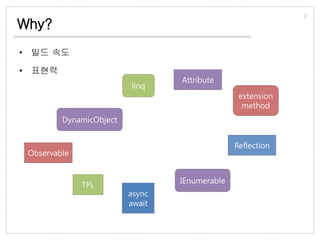

![Network
ŌĆó ļ╣ĀļźĖ Ēī©ĒéĘ ņ▓śļ”¼ļź╝ ņ£äĒĢ┤ ļ╣äļÅÖĻĖ░ IO ņé¼ņÜ®
4
var socket = new Socket(AddressFamily.InterNetwork,
SocketType.Stream, ProtocolType.IPv4);
// preprocess socket
var buffer = new byte[4096];
socket.BeginReceive(buffer, 0, buffer.Length, SocketFlags.None,
result => {
var received = socket.EndReceive(result);
// process packet
}, null /* state */);](https://image.slidesharecdn.com/csharpserver-140613015431-phpapp02/85/C-Game-Server-4-320.jpg)
![TaskCompletionSource
ŌĆó C++ Future + C# Task Awaitable Future
5
Network
static Task<int> ReceiveAsync(this Socket sock, byte[] buf, int off, int size)
{
var source = new TaskCompletionSource<int>(sock);
sock.BeginReceive(buf, off, size, SocketFlags.None, state =>
{
try
{
source.SetResult(socket.EndReceive(state));
}
catch (Exception e)
{
source.SetException(e);
}
}, source);
return source.Task;
}](https://image.slidesharecdn.com/csharpserver-140613015431-phpapp02/85/C-Game-Server-5-320.jpg)
![async, await
ŌĆó Task.Result ļ╣äļÅÖĻĖ░ ļīĆĻĖ░(await), ĻĘĖļ¤░ ņĮöļō£Ļ░Ć ņ׳ļŖö ĒĢ©ņłś(async)
6
Network
static async Task<byte[]> ReceiveAsync(this Socket socket, int count)
{
var buffer = new byte[count];
var length = 0;
do
{
var num = await ReceiveAsync(socket, buffer, length, count);
if (num == 0)
break;
length += num;
count -= num;
} while (count > 0);
if (length != buffer.Length) throw new IOException("packet is truncated.");
return buffer;
}](https://image.slidesharecdn.com/csharpserver-140613015431-phpapp02/85/C-Game-Server-6-320.jpg)
;
}
}
awaitĒĢśļŖö ņ¦ĆņĀÉņŚÉ ņĢäņ¦ü IO signalņØ┤ ņŚåļŗżļ®┤, ĒĢ┤ļŗ╣ TaskļŖö ņ×Āņŗ£ ļ®łņČöĻ│Ā,
Ļ░ĆņÜ®ĒĢ£ ļŗżļźĖ Taskļź╝ ņ░ŠņĢä ņłśĒ¢ēĒĢ©](https://image.slidesharecdn.com/csharpserver-140613015431-phpapp02/85/C-Game-Server-7-320.jpg)
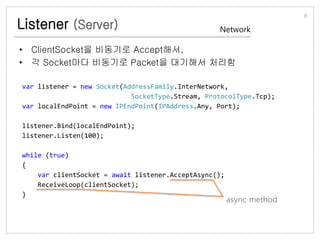
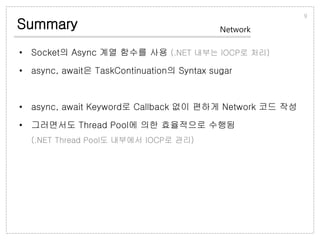
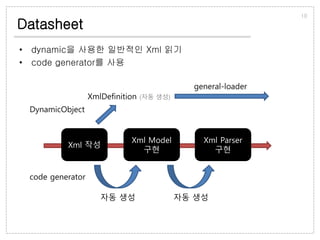
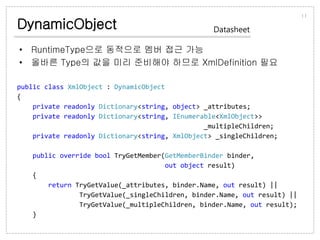
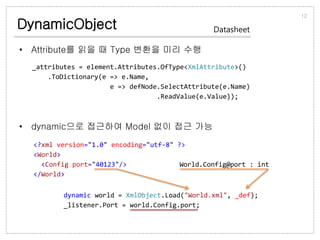
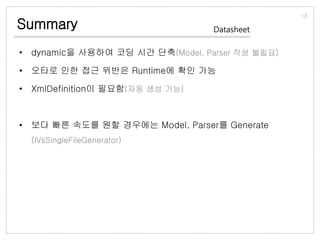
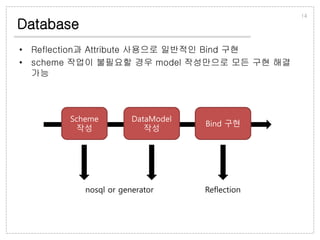
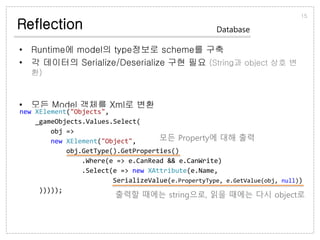
![Attribute
ŌĆó RuntimeņŚÉ ņĀæĻĘ╝ Ļ░ĆļŖźĒĢ£ metadataļź╝ ņĮöļō£ņŚÉ ņŻ╝ņ×ģ
16
Database
[CommandHandler("npc", "ņāłļĪ£ņÜ┤ Npcļź╝ ņāØņä▒ĒĢ®ļŗłļŗż")]
internal bool SpawnNpc(Entity admin,
[CommandArgument("NpcņØś ņØ┤ļ”ä")] string npcName,
[CommandArgument("NpcņØś X ņ£äņ╣ś", 0)] double newX,
[CommandArgument("NpcņØś Y ņ£äņ╣ś", 0)] double newY)
{
if (!admin.Has<Pos>())
return false;
var npc = EntityManager.Instance.Create(EntityTemplate.Ids.Npc);
npc.Get<Motion>().Dir = admin.Get<Motion>().Dir;
npc.Get<Nameplate>().Name = npcName;
npc.Get<Pos>().Assign(new Pos {X = newX, Y = newY});
ļ¬ģļĀ╣ņ¢┤ņÖĆ ņäżļ¬ģņØä ņĮöļō£ņŚÉ ĻĖ░ļĪØ
ņØĖņ×É ņäżļ¬ģĻ│╝ ĻĖ░ļ│Ė Ļ░Æ, typeņØä ņĮöļō£ņŚÉ ĻĖ░ļĪØ](https://image.slidesharecdn.com/csharpserver-140613015431-phpapp02/85/C-Game-Server-16-320.jpg)
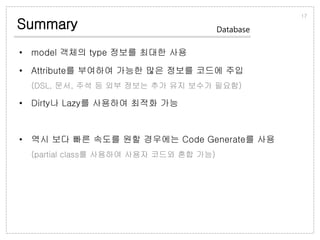

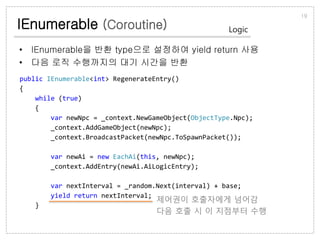
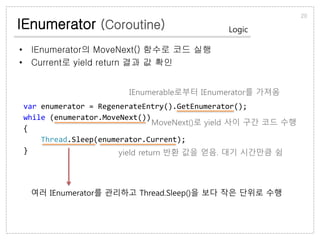
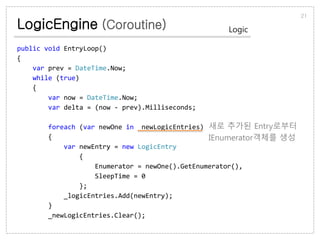
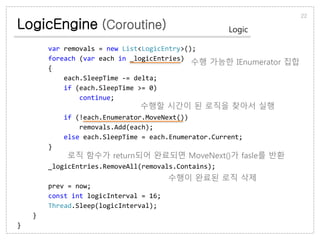
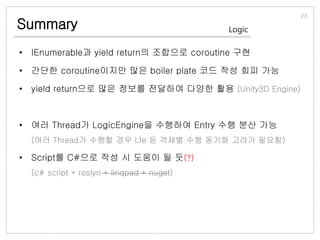
![Summary
ŌĆó async, awaitņØä ņé¼ņÜ®ĒĢ£ ļÅÖĻĖ░ņĀü Network(IO) ĒöäļĪ£ĻĘĖļלļ░Ź
ŌĆó dynamicņØä ņé¼ņÜ®ĒĢ£ Runtime type dispatch
ŌĆó Reflection, Attributeļź╝ ņé¼ņÜ®ĒĢ£ boiler plate ņĮöļō£ ņżäņØ┤ĻĖ░
ŌĆó AttributeļĪ£ metadataļź╝ ņĮöļō£ļĪ£ ĻĖ░ļĪØĒĢśņŚ¼ ņ£Āņ¦Ć ļ│┤ņłś ļ╣äņÜ® ņżäņØ┤ĻĖ░
ŌĆó coroutineņØä ņé¼ņÜ®ĒĢ£ ļÅÖĻĖ░ņĀü ļĪ£ņ¦ü ĒöäļĪ£ĻĘĖļלļ░Ź
24
ļ│┤ļŗż ņĀüņØĆ, ĻĘĖļ”¼Ļ│Ā ņ¦üĻ┤ĆņĀüņØĖ(ļÅÖĻĖ░ņĀü) ņĮöļö®ņ£╝ļĪ£ ņ£Āņ¦Ć ļ│┤ņłś ļ╣äņÜ® ņżäņØ┤ĻĖ░
ļåÆņØĆ Ēæ£ĒśäļĀź
ņä▒ļŖź ļ¼ĖņĀ£ļŖö ĒÜīļĪ£ņØś ļ░£ņĀäņØ┤ ĒĢ┤Ļ▓░ĒĢ┤ ņżä Ļ▓āņ×ģļŗłļŗż [...]](https://image.slidesharecdn.com/csharpserver-140613015431-phpapp02/85/C-Game-Server-24-320.jpg)
